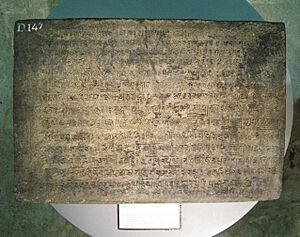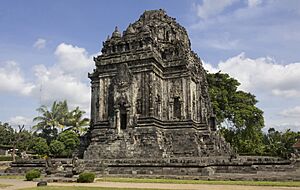Kalasan inscription facts for kids
Quick facts for kids Kalasan inscription |
|
|---|---|

Kalasan inscription, displayed at National Museum of Indonesia, Jakarta
|
|
| Material | Andesite stone |
| Writing | Pranagari script in Sanskrit |
| Created | 700 Saka (778 CE) |
| Discovered | Kalasan village, Sleman Regency, Yogyakarta, Indonesia |
| Present location | National Museum of Indonesia, Jakarta |
| Registration | D.147 |

The Kalasan inscription is an ancient stone writing from the year 700 Saka, which is 778 CE. It was found in a village called Kalasan in Sleman Regency, Yogyakarta, Indonesia. This important inscription is written in Sanskrit language using the Pranagari script, which comes from Northern India. It's super special because it's the very first inscription found in Indonesia that mentions the name of the powerful Sailendra royal family, calling them Sailendravamça.
What the Inscription Says
This old stone tells us a fascinating story about a wise teacher known as Guru Sang Raja Sailendravamçatilaka. This teacher, who was like a jewel of the Sailendra family, convinced a powerful ruler named Maharaja Tejapurnapana Panangkaran to build a special holy building. This building was for a goddess named Tara. The inscription also says that a Vihara, which is a monastery for Buddhist monks, was built for monks from the Sailendra family's kingdom.
Maharaja Panangkaran also generously gave the village of Kalaça to the Sangha, which is the Buddhist monastic community. Experts believe that the temple built for Tara is actually the famous Kalasan temple that we can still see today.
Today, you can see this amazing inscription at the National Museum of Indonesia in Jakarta. It has an inventory number: No. D.147.
Messages from the Past
The Kalasan inscription shares several important messages and requests from the past. It starts by honoring the goddess Tara, who is seen as a guide for people suffering in the world.
The inscription explains that the beautiful temple for Tara was built because the teachers of the Sailendra king asked for it. Maharaja Panangkaran agreed to this. It also mentions that a building for noble Buddhist monks, who were skilled in Mahayana teachings, was created.
Important officials like Pangkura, Tavana, and Tiripa were involved in building Tara's sacred place and the monks' building. The inscription highlights that these buildings were made during the time when the Sailendra dynasty was growing and powerful.
It says that Maharaja Panangkaran built the Tara temple to honor his teachers. This happened 700 years after the Saka era began. The village of Kalasa was given to the Buddhist community, with local leaders as witnesses.
The inscription also talks about a special gift called "bhura" given to the Sangha by the "king like a lion" (meaning a very strong king) from the Sailendra dynasty. It asks all future kings to protect this gift and follow the rules of Dharma, which are like good moral laws.
Finally, the inscription expresses a hope that by building the monastery, everyone can understand important sacred knowledge, the idea of cause and effect, and the different parts of existence according to Buddhism. Kariyana Panangkarana, the ruler, repeatedly asked future noble kings to always protect this important temple according to the rules.
See also
- Canggal inscription (732)
- Kelurak inscription (782)
- Karangtengah inscription (824)
- Mantyasih inscription (907)
- Laguna Copperplate Inscription (900)
- Sojomerto inscription (725)
- Tri Tepusan inscription (842)
- Buddhism in Indonesia
- Candi of Indonesia
- Indonesian Esoteric Buddhism
- Kedu Plain

